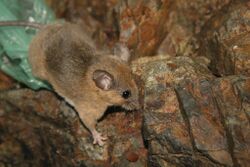Biology:Tres Marías Island mouse
| Tres Marias island mouse | |
|---|---|

| |
| Scientific classification | |
| Domain: | Eukaryota |
| Kingdom: | Animalia |
| Phylum: | Chordata |
| Class: | Mammalia |
| Order: | Rodentia |
| Family: | Cricetidae |
| Subfamily: | Neotominae |
| Genus: | Peromyscus |
| Species: | P. madrensis
|
| Binomial name | |
| Peromyscus madrensis Merriam, 1898
| |
The Tres Marías island mouse or Tres Marías deer mouse (Peromyscus madrensis) is a species of rodent in the family Cricetidae.[2] It is found only on the Islas Marías off the west coast of Mexico (part of the state of Nayarit). When last assessed, it was common on María Cleofás Island, but rare or absent on the other, more disturbed, islands.[1]
Description
The Tres Marías island mouse is the size of a small rat, with a head and body measuring 21 to 25 centimetres (8.3 to 9.8 in), and a tail 10 to 13 centimetres (3.9 to 5.1 in) in length. They have pale tan fur, with white underparts, lips, and feet. There is a faint stripe of darker fur towards the rear of the animal's back, and there are dark spots on the ankles. The tail has relatively little hair, and is noticeably darker on the upper surface. Females have six teats.[3] Compared with other closely related species, it is larger, with a longer tail, smaller ears, and a smaller penis.[4]
Biology
Although found on all habitats on the islands, the Tres Marias island mouse is most common in undisturbed tropical deciduous forest, especially in the interior highlands.[4] It lives in sheltered locations, such as under logs or rocks.[5] Widespread on the islands when they were first described in 1898,[3] a survey in 1991 showed a significantly reduced range for the mice, apparently due to the introduction of non-native species, such as black rats, deer, and goats.[5]
The species is closely related to the Nayarit mouse, which inhabits the nearby mainland, with the two species diverging during the Pleistocene. It is unclear whether the mice first arrived on the islands by rafting from the mainland, or whether the islands were once connected to the mainland.[3]
References
- ↑ 1.0 1.1 Álvarez-Castañeda, S.T.; Lacher, T.; Vázquez, E. (2018). "Peromyscus madrensis". IUCN Red List of Threatened Species 2018: e.T16671A22361002. doi:10.2305/IUCN.UK.2018-1.RLTS.T16671A22361002.en. https://www.iucnredlist.org/species/16671/22361002. Retrieved 17 November 2021.
- ↑ Musser, G.G.; Carleton, M.D. (2005). "Superfamily Muroidea". in Wilson, D.E.; Reeder, D.M. Mammal Species of the World: A Taxonomic and Geographic Reference (3rd ed.). Johns Hopkins University Press. p. 1071. ISBN 978-0-8018-8221-0. OCLC 62265494. http://www.departments.bucknell.edu/biology/resources/msw3/browse.asp?id=13000463.
- ↑ 3.0 3.1 3.2 Álvarez-Castañeda, S.T.; Méndez, L. (2005). "Peromyscus madrensis". Mammalian Species 774: Number 774: pp. 1–3. doi:10.1644/1545-1410(2005)774[0001:PM2.0.CO;2].
- ↑ 4.0 4.1 Carleton, M.D. (1982). "Distribution and systematics of Peromyscus (Mammalia: Rodentia) of Nayarit, Mexico". Smithsonian Contributions to Zoology 352 (352): 1–46. doi:10.5479/si.00810282.352. http://www.sil.si.edu/eresources/silpurl.cfm?purl=07948577.
- ↑ 5.0 5.1 Wilson, D.E. (1991). "Mammals of the Tres Marias Islands". Bulletin of the American Museum of Natural History 206: 214–250.
Wikidata ☰ Q1768362 entry
 |


